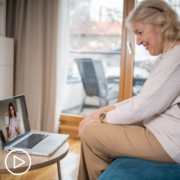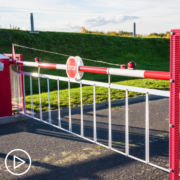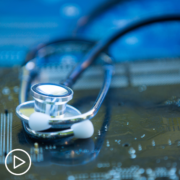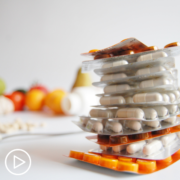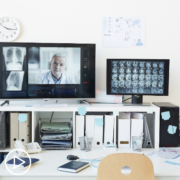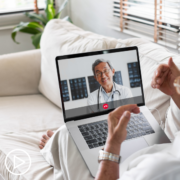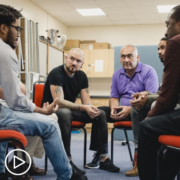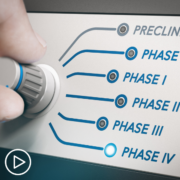What Are Risks and Rewards of Telemedicine in MPN Care? from Patient Empowerment Network on Vimeo.
How can telemedicine provide benefits and risks in MPN care? Watch as experts Dr. Joseph Sirintrapun and Dr. Jeanne Palmer explain benefits and risks of telemedicine and some of the logistics and lab test procedures and analysis.
Download Resource Guide
See More from MPN TelemEDucation
Related Resources:
Transcript:
Lisa Hatfield:
Okay. So, Dr. Sirintrapun, the importance of connecting to specialized care when living with a rare cancer is so paramount. But with anything comes risk and rewards. What are the risks and rewards of telemedicine and maybe even some of the limitations? You both touched on that a little bit. But if you can talk about that a little bit, that would be great.
Dr. Sirintrapun:
Yeah, I’m so glad that Dr. Palmer actually illustrated to everybody, including myself, kind of how the processes work and if you had a trial, particularly with monitoring, and getting the right tests. So being a pathologist, that’s the other hat, I look at glass slides, but I also handle a lot of tests in particular, is looking at them. And in Memorial we do those complex humongous genome panels, it’s actually become much more commonplace to have 500 genes. And as Dr. Palmer had alluded to, sometimes you don’t know out of the 500, which are really meaningful, which are not. But out of that, you do know with some of them. I see it like the initial diagnosis, at least with technology, like the complex testing being done, still centered. It’s hard to outsource that to locally.
But in terms of convenience, I can see a future where a lot of these tests can be done more closer to the patient, where they’re simpler, there’s more automation. Somebody who might be a lab tech or nurse practitioner might, the instrument might be simple enough to press a button and you’ll get your results. And that’ll be just the right amount of genomes to monitor. Now going back to rare diseases and such, it depends on the rare disease. Because rare diseases have been kind of the classic paradigm for a clinical trial where you have to go to a centralized center because a lot of times the way rare diseases work is that they’re, at least in pathology, there centrally to an expert. Because there’s only one person that’s ever looked at it in the entire world and nobody else really knows. And you end up sending it to that guru.
And so the problem with that is that somebody has to know from the outside, “Hey, I think it’s this, I should send it to that person.” So you have, you already have friction and a gap right there. And you have the logistics of it just, okay, once it’s there and you get the diagnosis, what happens next? Can the patient who might be living from wherever be able to go and get enrolled in that trial? So you have all these different barriers that I alluded to before. So the advantage of the telemedicine is that you basically might have diminished the gap. You can bring that expert in terms of consultation to the patient who lives very far away. Now, going back to all the logistics about monitoring, if you had the right lab tests, and this is where the FDA comes in, and we don’t have time to go into the way lab tests are developed, but if the lab test is simple enough, you can do the monitoring more closer to the patient.
And in that way the clinical trial is much more enabling. They don’t have to fly somewhere, you have to go some…it all depends on how they can actually get the test to the right quality level and closer to the patient so that you can have the monitoring as more frequently and you don’t have the cost of actually having to ship either the patient or the sample elsewhere. So things that are changing, I’m hoping, because the technology’s there and it takes architects of clinical trials to rethink that. What’s the right technology now that we can apply it locally, so that we don’t have to do all this back and forth. And so that’s the type of thing. So going with the record, there’s lots of opportunity. I think the cautionary part would be is that tech, if you’re going to deploy something, let’s say near the patient, we call it point of care in lab testing, point of care, right?
Right, right near the patient. You have to make sure that lab test is quality, it’s actually good enough, like it met all the standards, and then you can trust the results. That’s the trick. And that’s where the cautionary part comes in. Are these things really good enough that anybody with a little experience can use it and that people can interpret the result and you can trust the result. That all these things are in place. I’m giving you the ins and outs with the way, when you want to deploy something, these are the different things you have to consider. But there’s a lot of potential as I mentioned.
Lisa Hatfield:
Sure. Great. Dr. Palmer, do you have anything that you want to share or add to that? Risks, rewards, limitations for MPN patients about telemedicine?
Dr. Palmer:
So, I think that brought up a really good point. So when we look at these tests that you can order, I think there’s a lot of companies that do very reputable tests that are even sometimes utilized by some centers. And so at the first diagnosis, I think there’s the piece that what is going to help clinically based on the knowledge that we know, and that is some of these tests that actually can, are very good quality have somebody to be deployed, draw the blood, send it to wherever and do the test. Sometimes it’s good to be at the center itself where there’s actually labs and that increases the learning. I think that the architecture of the clinical trial which was a great way to put it, is going to be really important, because if I take a complete blood count, honestly, I mean, anyone can do a complete blood count and I can get the information that I really need to get out of it.
If we look at drug levels, that’s a far different animal is to make sure that these drug levels get drawn in the right way at the right time, sent to the right place. That can be a real challenge. So there are going to be different aspects of the clinical trial that can and cannot be done virtually and through outside resources. So I think that, that it’s certainly not all created equal. So there’s no way I can do the entirety of a clinical trial without physically having a patient at the center. However, on the other side of that coin, I think there’s probably a number of things, especially with like really routine visits where we’re not getting drug levels, we’re just checking a CBC, or a complete blood count or chemistries or something in the blood, that that can probably be done almost anywhere.
So it’s just going to take an extra layer of thought. I think that a lot of times you use what you know, so you say, “Well, this is how this clinical trial was run and they have to come in and they have to get an exam and they have to get a CBC and they have to get everything else.” I think that there’s going to be ways that we can alter that to really think what are the meaningful things we need? Like we don’t use every single solitary time point, What are the safety measures we need to make sure we capture? So it is going to require sort of a lot of thoughtful processing to figure out how to do that. The other thing to be cautious about is if you have the interpretation of the test.
So let’s say I send out a lab to one of the companies that does really extensive panels of genes, and then it goes back to their primary provider. They might look at that and go, “Well, geez, I don’t know what any of this actually means.” I mean, frankly, out of those 400 genes, there’s a number of them that I don’t even know how to interpret. I say, “Well, this is interesting, but these are the ones that I know are really critically important and can impact your, what I anticipate is going to happen to you. But some of these we don’t know yet.” I mean, I think that’s what we’re learning about. So doing these tests, sometimes getting these big panels can be confusing and frankly scary if you don’t have somebody there who is able to say, “Yes, these are the important ones. These are probably not that important. So it’s interesting that you have them, but we don’t need to worry about them right now.”
And so that’s really key, because otherwise you start to go to Dr. Google and, which is not anybody’s friend, and get yourself really terrified. So I think that that ability to put things into perspective is also, and have the ability to incorporate it into the education given and the treatment plan is really critical. So again, a hybrid model is really necessary for a lot of these to work well. And how that hybrid model works is going to be dependent on the disease type, the clinical trial in that situation. But I think that there’s ways to do it, and I personally in my own practice have created a set of rules that I’m like, “Okay, well, for this and this and this and for this you have to do that and I need to do this.” So I have certain things set up to make sure that I feel like I am providing safe care, but also being able to provide it virtually.
Share Your Feedback:
Create your own user feedback survey
